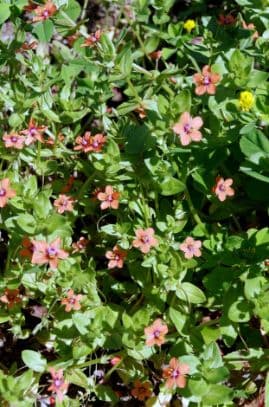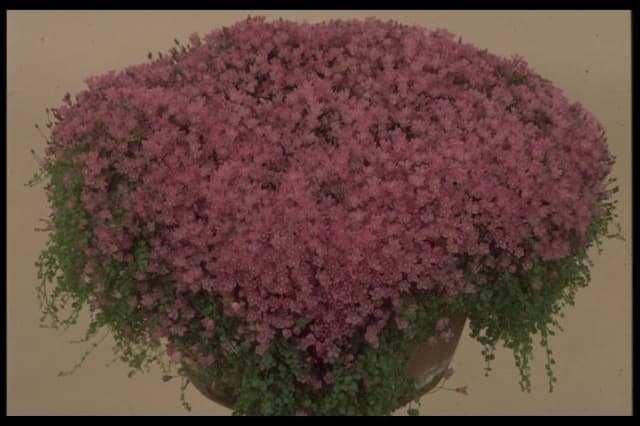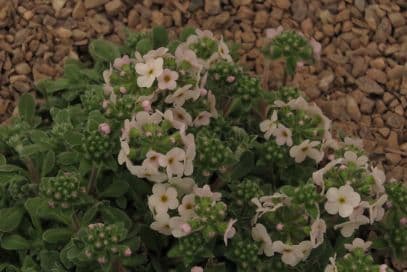Bear's ear auricula Primula auricula 'Arundell' (Au/s/st)

ABOUT
The Primula auricula 'Arundell', commonly known as Auricula or Bear's Ear, is a captivating plant with unique and attractive features. It possesses a rosette of soft, velvety leaves that are often green to bluish-green in hue. The leaves may contain a powdery dusting, giving them a frosted appearance and are slightly rounded with a somewhat succulent texture. The most distinctive aspect of the Auricula 'Arundell' is its flowers, which bloom in clusters that rise above the foliage on slender stalks. The blossoms themselves are typically rich and vivid in color, with this variety showcasing shades that may range from deep purples to reds, often with a contrasting center or eye that can be yellow or white. The flowers are composed of several rounded petals, often overlapping, creating a sense of depth and fullness. The overall presentation of the Auricula 'Arundell' is one of elegance and charm, with its lush foliage providing a perfect backdrop for the striking flowers that draw the eye and often become a focal point in gardens or as part of a collection of plants. The contrast of colors and the velvety texture of both the leaves and petals make it a prized specimen for plant enthusiasts and gardeners seeking something truly special for their displays.
About this plant
 Names
NamesFamily
Primulaceae
Synonyms
Bear's Ear Auricula, Mountain Cowslip, Auricula Primrose
Common names
Primula auricula 'Arundell' (Au/s/st).
 Toxicity
ToxicityTo humans
The Common Auricula is not known to be highly toxic to humans when ingested in small amounts. However, like many plants, it may cause mild stomach upset if ingested in larger quantities. Handling the plant can sometimes result in skin irritation or dermatitis in sensitive individuals, due to the presence of certain plant compounds. If ingested, symptoms may include nausea, vomiting, or diarrhea. It is always advisable to keep plants away from children who might ingest them and to wash hands after handling plants that could cause skin irritation.
To pets
The Common Auricula is considered non-toxic to pets such as dogs and cats. Ingesting the plant is not likely to cause more than mild gastrointestinal upset. However, as a general rule, pets should not be allowed to consume ornamental plants as they might cause vomiting or diarrhea. If a pet does ingest a significant amount of the plant and displays signs of distress, it is best to consult a veterinarian.
 Characteristics
CharacteristicsLife cycle
Perennials
Foliage type
Evergreen
Color of leaves
Green
Flower color
Varies
Height
6-8 inches (15-20 cm)
Spread
6-8 inches (15-20 cm)
Plant type
Herb
Hardiness zones
5
Native area
Europe
Benefits
 General Benefits
General Benefits- Decorative Appeal: Adds vibrant color and visual interest to gardens and container plantings.
- Attracts Pollinators: Invites beneficial insects such as bees and butterflies, supporting biodiversity.
- Easy to Grow: Known for being a low-maintenance plant that can thrive in various conditions.
- Long Flowering Period: Offers an extended display of blooms, usually from spring to summer.
- Diverse Uses: Can be used in rockeries, borders, and alpine gardens for aesthetic diversity.
- Compact Growth: Suitable for small spaces due to its modest size.
- Cold Hardy: Capable of withstanding cooler temperatures, making it suitable for temperate climates.
 Medical Properties
Medical Properties- Anti-inflammatory: Primula auricula has been traditionally used for its potential anti-inflammatory effects.
- Expectorant: It is sometimes used for its expectorant properties, to help clear mucus from the respiratory tract.
- Diuretic: The plant may also act as a natural diuretic, helping in the removal of excess fluid from the body.
 Air-purifying Qualities
Air-purifying QualitiesThis plant is not specifically known for air purifying qualities.
 Other Uses
Other Uses- Photography: The unique shapes and colors of Primula auricula 'Arundell' can serve as a striking subject or backdrop in macro and botanical photography.
- Fabric dye: Historically, some Primula species have been used to create dyes, and the petals of Primula auricula 'Arundell' could potentially be used for coloring textiles.
- Performance stages: The blossoms of the plant can be utilized to decorate sets for plays, operas, or other performances where a naturalistic element is needed on stage.
- Edible decoration: Its flowers can be used as edible decorations for cakes and desserts, provided they have been grown without harmful chemicals.
- Teaching tool: The plant can be used in biology classes to teach students about plant anatomy, reproduction, and hybridization.
- Bonsai companion: The small size of Primula auricula 'Arundell' makes it suitable as an underplanting or companion plant in bonsai displays.
- Floral crafts: Dried flowers of the Auricula can be used in potpourri or to create natural, decorative crafts such as bookmarks or pressed flower art.
- Feng Shui: In some practices, the plant is used in Feng Shui to attract positive energy into the home when placed in the right area.
- Scientific research: This cultivar could be studied for its genetic traits and breeding potential to produce new Primula varieties.
- Seasonal festivals: Due to its springtime flowering, it can be integrated into celebrations or festivals that commemorate spring, such as garden shows or horticultural exhibits.
Interesting Facts
 Feng Shui
Feng ShuiThe plant Auricula is not used in Feng Shui practice.
 Zodiac Sign Compitability
Zodiac Sign CompitabilityThe plant Auricula is not used in astrology practice.
 Plant Symbolism
Plant Symbolism- Uniqueness: With its distinctive ear-like petals, Auricula (the most common common name of Primula auricula 'Arundell') often symbolizes the uniqueness or rarity in the plant world, indicating the preciousness of individual characteristics.
- Patience: As a plant that may take some time to flourish, the Auricula can represent the virtue of patience, encouraging people to wait calmly for outcomes or rewards.
- Attention to Detail: The intricate patterns and colors of the Auricula flowers suggest a symbolism related to the appreciation of details and meticulousness.
- Boldness: The vibrant, often contrasting colors of the Auricula align with symbols of courage and taking a stand, much like its blooms stand out in a garden setting.
- Perseverance: Able to grow in rocky, alpine regions, the Auricula epitomizes the ability to endure and thrive in challenging conditions, symbolizing perseverance in adversity.
 Water
WaterThe Primula auricula, commonly known as Bear’s Ear, should be watered thoroughly, allowing the top inch of soil to dry out between waterings. In general, watering once a week is a good starting point, but you should adjust this frequency depending on temperature and humidity. Use room temperature water to avoid shocking the plant's roots. It's best to water the plant at the base to avoid getting water on the foliage, which can lead to fungal diseases. A good guideline would be to provide approximately 1 gallon of water per week, making adjustments as needed for the plant's environment and the season.
 Light
LightBear’s Ear prefers bright, indirect light and should be placed in a location that receives morning sunlight and shade in the afternoon. It is important to protect it from the harsh midday sun, which can scorch its leaves. An east-facing window or a spot that receives filtered light through a sheer curtain is ideal for this plant.
 Temperature
TemperatureBear’s Ear thrives in cooler temperatures, with ideal conditions ranging between 50-60 degrees Fahrenheit. However, it can tolerate temperatures as low as 40 degrees and as high as 75 degrees Fahrenheit. Keeping the plant in a cool room away from drafts and sudden temperature changes is optimal for its growth.
 Pruning
PruningBear’s Ear benefits from pruning to remove dead or faded flowers and to encourage bushier growth. The best time to prune is after the flowering period in the late spring or early summer. You should prune the plant every year to maintain its shape and promote healthy new growth.
 Cleaning
CleaningAs needed
 Soil
SoilBear's Ear requires a well-draining mix, with loamy or sandy soil ideal. A mixture of one part garden soil, one part peat, and one part perlite or sand facilitates drainage. This plant prefers a slightly alkaline pH of about 7.0 to 8.0.
 Repotting
RepottingBear's Ear should be repotted every two years to ensure fresh soil and room for root growth. The best time to repot is in the spring just after flowering or in the autumn.
 Humidity & Misting
Humidity & MistingBear's Ear thrives in moderate humidity levels, between 50-60%. Avoid placing the plant in overly dry environments or where the air is too damp.
 Suitable locations
Suitable locationsIndoor
Place Bear’s Ear in bright, indirect light and ensure good air circulation.
Outdoor
Bear's Ear prefers partial shade and shelter from strong winds.
 Life cycle
Life cycleThe life of Primula auricula 'Arundell' (commonly known as Auricula or Bear's Ear Auricula), begins with seed germination which occurs in a moist, well-drained soil in partial shade, typically in late winter to early spring. Seedlings emerge and develop into rosettes of fleshy, often attractively colored leaves. After a period of vegetative growth, the plant reaches maturity and produces tall flower stalks, each bearing several ornate, often brightly colored and patterned flowers in shades ranging from yellows and oranges to reds and purples, usually appearing in mid to late spring. Once pollinated, possibly by insects like bees, the flowers develop into capsules containing numerous tiny seeds. At the end of the growing season, the plant may go dormant, with above-ground parts dying back and the plant surviving as an underground rootstock in colder climates. The life cycle repeats when the plant emerges again from dormancy the following spring, or the seeds disperse and germinate to produce new plants.
 Propogation
PropogationPropogation time
Spring to Summer
The Primula auricula, commonly known as Auricula, can be propagated through division, which is the most popular method for this species. Division is typically done in late summer or early fall after the plant has finished blooming. To propagate by division, carefully lift the plant from the ground and use a sharp knife or spade to divide the clump into smaller sections, ensuring that each section has at least one bud or shoot and a portion of the root system. These divisions can then be replanted in well-drained soil at the same depth they were growing previously and watered in. This process encourages rejuvenation and can help to maintain the vigor of the plants, as well as produce new Auricula plants that are true to the parent's characteristics.









